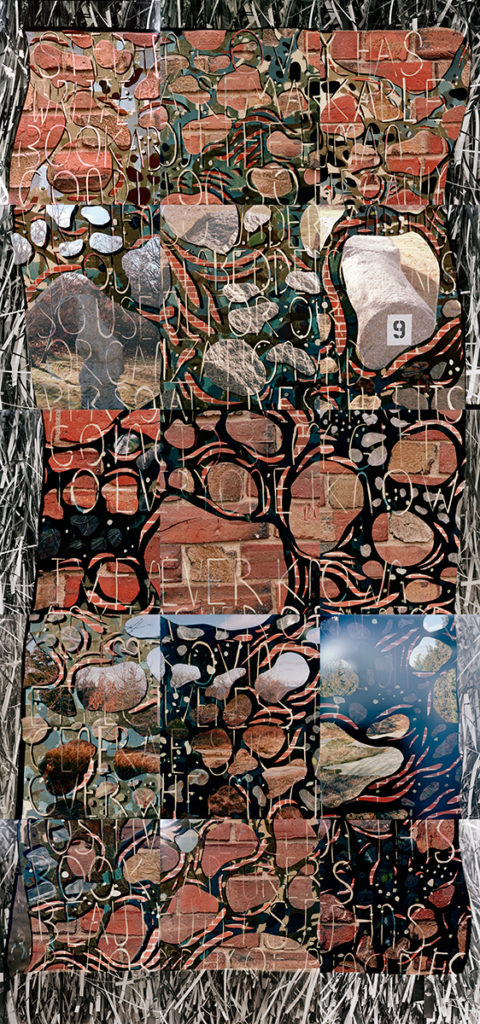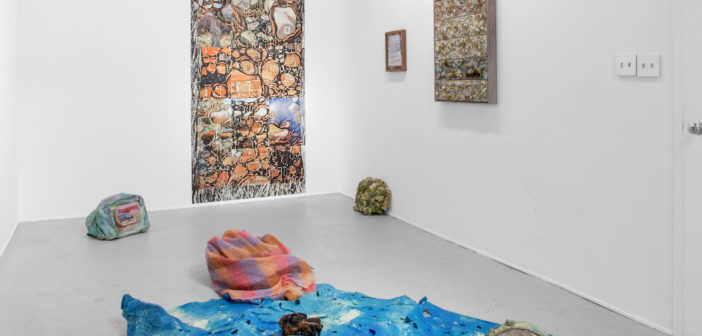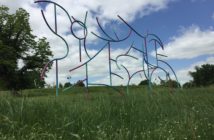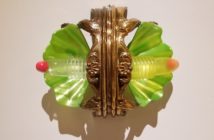The sixteen busy sculptures, panels, and photographic collages in this strange, compact show hang back coolly in the space, waiting for the viewer to draw them out. Audrey Hope’s and Dan Boardman’s works are so encrusted with information that the heterogeneity of their accumulation becomes a homogeneous tar. The variation of information is so evenly dense that it has a lulling, entrancing effect. But when one steps closer and allows one’s eyes to settle, the works transmute.
Curator Sean Downey says he’s been reading and re-reading Solaris by Stanislaw Lem:
In the book there’s the unnameable, almost-namable thing; an ocean comes into being and then forms images and then dissipates. People are trying to make sense of what these forms and images are, and the intentions behind it. What they realize at a certain point is that the ocean (which is like a kind of living planet) is trying to make sense of them.
Downey also talks about the way Solaris seems to be a bellwether. It's about an intelligent system capable of reflexive meta-thought, much like our culture’s technological progress in its ability to predict tastes and behaviors that can ultimately shape individual identity.
Audrey Hope’s Panel (pistachio) is almost gray from a few steps away but is shimmering and dense in microscopic, tiny detail when seen from a closer vantage point. It looks like sharkskin. This piece seems to augment one’s vision, giving the viewer the superpower to see microscopic details. One sees an excruciatingly clear, glitzy microbiome of encrusted jewels and trinkets, sands, roes, powders and coatings, revealed as if through a lens of shallow water in a girly tidal pool. The piece is not deploying feminine adornment, it’s making a true and resonant beauty using flotsam and jetsam. It tells viewers that their keenness of vision is crucial to the beauty of this work.

Audrey Hope, Kitty Rock III, photograph printed on canvas, plaster-soaked burlap, caulk, spray paint, wood and wire frame, 30 x 18 x 20 inches, 2016.
Hope’s Kitty Rock III is a talismanic photograph/sculpture. (The disciplines in this show bubble up into recognition, only to disappear again beneath the surface.) It’s as if this hilarious rock wrapped in a shawl is intentionally pulling an image of a cat to its surface. This adorned rock might be the photographer/sculptor's touchstone, having the ability to determine any viewer's most pleasing photograph. Hope’s other sculptural works are also charms. Ball is an ugly wadded-up volume of matted fur that is stitched and lovingly jerry-rigged. Through strange ritual processes, the base material is made into a magical thing.
Dan Boardman’s photographic and textual collages are like changing tapestries or living maps that show a shifting terrain. These large wall pieces diagram a formula for a correct life which is visually chanted over the landscape. Boardman takes large format photographs in the natural landscape–an apparatus-laden process that has been misunderstood as dark magic. But in an additional layer of incantation, before he exposes the film, he masks it with cut amoebic shapes and hand-cut self-help texts. Rather than being printed, a text is messily slashed into barely legible words. Beauty is made sad by this cutting, seeming to refer to self-mutilation and religious scrupulosity. Boardman's works look for answers in nature and chide the genre of self-help while looking to them for answers as one would look to a religious text.

Dan Boardman, Reviews, 4 x 5 photographs tiled, photographs made in camera, 50 x 110 inches, 2016.
His piece Reviews includes The Seven Habits of Highly Effective People–not the habits themselves but the book’s glowing reviews that humorously comprise much of the book. An over-systematized model of a self-congratulatory mode of living is layered over the natural world, hiding it. Peering at the large wall piece, it's hard keep one’s balance. No sooner does the piece reveal a small group of stones than it revises them with a handmade amoeba, a lens flare, or more surprisingly, large words that weren’t apparent a moment before. One feels captured by this unnerving transmutation. I suspect Boardman’s works reveal themselves in different permutations to each viewer, making each person feel as though the act of looking informs the creation of each artwork.
Boardman's and Hope's works seem alive and sentient, revealing information to each viewer individually. Like the surface of Solaris, the artworks seem to know the viewer. They are mysteriously charged in an unnameable way. They are spiritual objects. Their parts are humble, but the accumulation and the strange formulations yield something alchemical and transcendent. This is a captivating, difficult exhibition that displays the mystical power of art to show us ourselves.
Dan Boardman / Audrey Hope will be on view at Kijidome through July 24, 2016. Kijidome is an experimental project space and collaborative founded by four artists: Sean Downey, Carlos Jiménez Cahua, Lucy Kim, and Susan Metrican. Located in Boston’s South End, the space presents curatorial projects and events by its four founders and invited guests.




